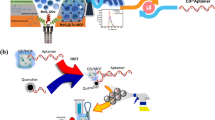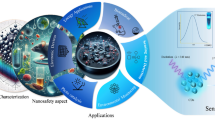Abstract
A new fluorescence “turn-on” nanosensor for carbonate determination was reported based on CdSe quantum dots (QDs) modified with thio ligands containing urea groups: N-(5-mercapto-1,3,4-thiadiazol-2-ylcarbamoyl)-2-(o-tolyloxy)acetamide (AASH-CdSe QDs). The AASH-CdSe QDs were prepared through a ligand exchange process and characterized by transmission electron microscopy (TEM), fluorescence spectroscopy, UV-vis spectroscopy and FT-IR spectroscopy. The synthesized AASH-CdSe QDs allowed a selective fluorescence “turn-on” response towards carbonate. Under optimal conditions, the relative fluorescence intensity increases linearly with carbonate concentration in the range 1 × 10−7–1 × 10−4 M with a detection limit of 2.3 × 10−8 M. A Langmuir-type binding model was highly effective in describing the carbonate concentration dependence of the luminescence intensity of the AASH-CdSe QDs. The possible mechanism was discussed.
Similar content being viewed by others

Notes and references
P. A. Gale, S. E. Garcia-Garrido and J. Garric, Anion receptors based on organic frameworks: highlights from 2005 and 2006, Chem. Soc. Rev., 2008, 37, 151–190.
M. J. Little and P. D. Wentzell, Evaluation of acoustic emission as a means of carbonate detection, Anal. Chim. Acta, 1995, 309, 283–292.
H. K. Lee, H. Oh, K. C. Nam and S. Jeon, Urea-functionalized calix[4]arenes as carriers for carbonate-selective electrodes, Sens. Actuators, B, 2005, 106, 207–211.
H. M. Yeo, B. J. Ryu, K. C Nam, Synthesis of indolo[3,2-b]carbazole-based new colorimetric receptor for anions: A unique color change for fluoride ions, Org. Lett., 2008, 10, 2931–2934.
G. Hennrich, H. Sonnenscheinb, U. Resch-Genger, Fluorescent anion receptors with iminoylthiourea binding sites—selective hydrogen bond mediated recognition of CO32−, HCO3− and HPO42−, Tetrahedron Lett., 2001, 42, 2805–2808.
X. L. Zhang, Y. Xiao and X. H. Qian, A ratiometric fluorescent probe based on FRET for imaging Hg2+ ions in living cells, Angew. Chem., Int. Ed., 2008, 47, 8025–8029.
T. Gunnlaugsson, A. P. Davis, J. E. O’Brien and M. Glynn, Fluorescent sensing of pyrophosphate and bis-carboxylates with charge neutral PET chemosensors, Org. Lett., 2002, 4, 2449–2452.
E. R. Goldman, I. L. Medintz, J. L. Whitley, A. Hayhurst, A. R. Clapp, H. T. Uyeda, J. R. Deschamps, M. E. Lassman and H. Mattoussi, A Hybrid quantum dot-antibody fragment fluorescence resonance energy transfer-based TNT sensor, J. Am. Chem. Soc., 2005, 127, 6744–6751.
V. Thiagarajana and P. Ramamurthy, Specific optical signalling of anions via intramolecular charge transfer pathway based on acridinedione fluorophore, J. Lumin., 2007, 126, 886–892.
S. Watanabe, O. Onogawa, Y. Komatsu and K. Yoshida, Luminescent metalloreceptor with a neutral bis(acylaminoimidazoline) binding site: optical sensing of anionic and neural phosphodiesters, J. Am. Chem. Soc., 1998, 120, 229–230.
Z. H. Lin, Y. G. Zhao, C. Y. Duan, B. G. Zhang and Z. P. Bai, A highly selective chromo- and fluorogenic dual responding fluoride sensor: naked-eye detection of F ion in natural water a test pape, Dalton Trans., 2006, 3678–3684.
J. Bourson, J. Pouget and B. Valeur, Ion-responsive fluorescent compounds. 4. Effect of cation binding on the photophysical properties of a coumarin linked to monoaza- and diaza-crown ethers, J. Phys. Chem., 1993, 97, 4552–4557.
T Gunnlaugsson, A. P. Davis, J. E. O’Briena and M. Glynn, Synthesis and photophysical evaluation of charge neutral thiourea or urea based fluorescent PET sensors for bis-carboxylates and pyrophosphate, Org. Biomol. Chem., 2005, 3, 48–56.
L. L. Zhou, H. Sun, H. P. Li, H. Wang, X. H. Zhang, S. K. Wu and S. T. Lee, A novel colorimetric and fluorescent anion chemosensor based on the flavone quasi-crown ether-metal complex, Org. Lett., 2004, 6, 1071–1074.
D. Aldakov, M. A. Palacios, P. Anzenbacher, Jr., Benzothiadiazoles anddipyrrolyl quinoxalines with extended conjugated chromophores—fluorophores and anion sensors, Chem. Mater., 2005, 17, 5238–5241.
Y. H. Chan, J. Chen, Q. Liu, S. E. Wark, D. H. Son and J. D. Batteas, Ultrasensitive copper(II) detection using plasmon-enhanced and photo-brightened luminescence of CdSe quantum dots, Anal. Chem., 2010, 82, 3671–3678.
S. Ding, J. Chen, H. Jiang, J. He, W. Shi, W. Zhao and J. Shen, Application of quantum dot-antibody conjugates for detection of sulfamethazine residue in chicken muscle tissue, J. Agric. Food Chem., 2006, 54, 6139–6142.
H. B. Li and X. Q. Wang, Tuning the fluorescence response of surface modified CdSe quantum dots between tyrosine and cysteine by addition of p-sulfonatocalix[4]arene, Photochem. Photobiol. Sci., 2008, 7, 694–699.
R. Freeman, R. Gill, I. Shweky, M. Kotler, U. Banin and I. Willner, Biosensing and probing of intracellular metabolic pathways by NADH-sensitive quantum dots, Angew. Chem., Int. Ed., 2009, 48, 309–313.
H. B. Li, C. H. Han and L. Zhang, Synthesis of cadmium selenide quantum dots modified with thiourea type ligands as fluorescent probes for iodide ions, J. Mater. Chem., 2008, 18, 4543–4548.
L. Fabbrizzi, A. Leone and A. Taglietti, Chemosensing ensemble for selective carbonate detection in water based on metal–ligand interactions, Angew. Chem., Int. Ed., 2001, 40, 3066–3069.
R. C. Mulrooney, N. Singh, N. Kaur and J. F. Callan, An “off-on” sensor for fluoride using luminescent CdSe/ZnS quantum dots, Chem. Commun., 2009, 686–688.
S. Nishizawa, P. Bühlmann, K. P. Xiao and Y. Umezawa, Application of a bis-thiourea ionophore for an anion selective electrode with a remarkable sulfate selectivity, Anal. Chim. Acta, 1998, 358, 35–44.
S. Amemiya, P. Bühlmann, Y. Umezawa, R. C. Jagessar and D. H. Burns, An ion-selective electrode for acetate based on a urea-functionalized porphyrin as a hydrogen-bonding ionophore, Anal. Chem., 1999, 71, 1049–1054.
L. Qu and X. Peng, Control of photoluminescence properties of CdSe nanocrystals in growth, J. Am. Chem. Soc., 2002, 124, 2049–2055.
V. V. Breus, C. D. Heyes and G. U. Nienhaus, Quenching of CdSe-ZnS core-shell quantum dot luminescence by water-soluble thiolated ligands, J. Phys. Chem. C, 2007, 111, 18589–18594.
H. Benesi and H. Hildebrand, A spectrophotometric investigation of the interaction of iodine with aromatic hydrocarbons, J. Am. Chem. Soc., 1949, 71, 2703–2707.
Author information
Authors and Affiliations
Corresponding author
Rights and permissions
About this article
Cite this article
Han, C., Cui, Z., Zou, Z. et al. Urea-type ligand-modified CdSe quantum dots as a fluorescence “turn-on” sensor for CO32− anions. Photochem Photobiol Sci 9, 1269–1273 (2010). https://doi.org/10.1039/c0pp00119h
Received:
Accepted:
Published:
Issue Date:
DOI: https://doi.org/10.1039/c0pp00119h



